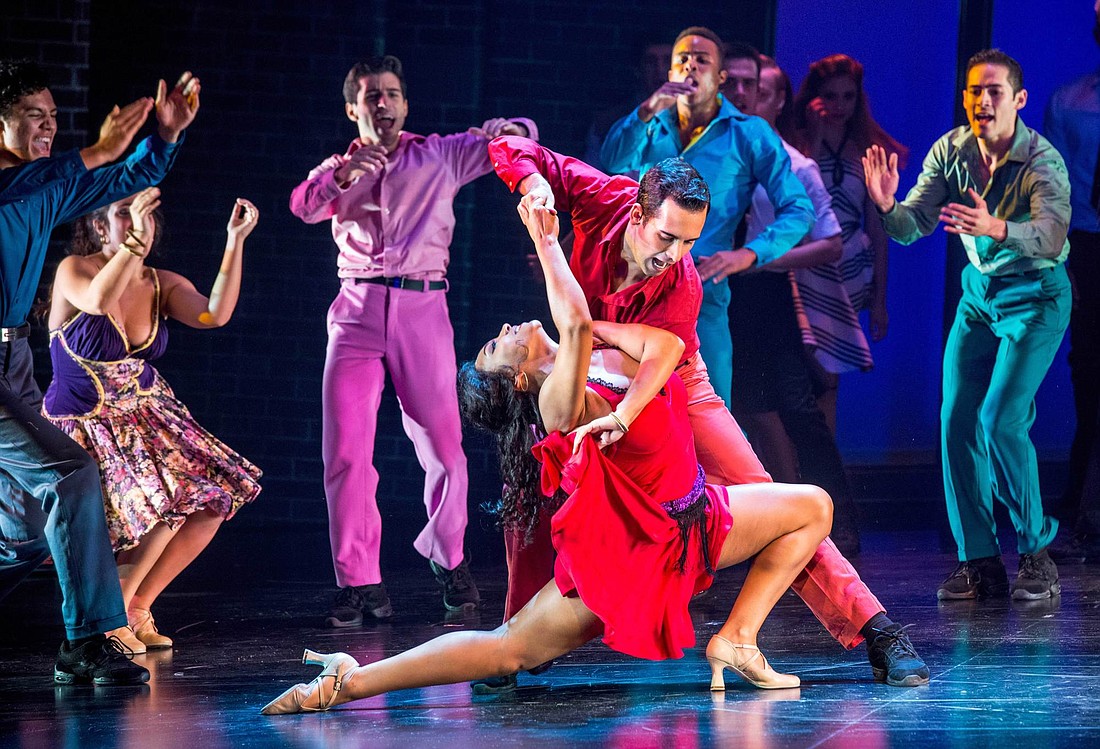- November 23, 2024
-
-
Loading

Loading

Shakespeare’s words, written in the 1590s, were the music that made us weep over the tragic story of Romeo and Juliet. In the 1950s, Leonard Bernstein gave us the music that amazingly intensified one of the most tragic of all dramatic tragedies. Now, The Asolo Repertory Theatre takes this timeless story, score, dancing and choreography to an almost unbearable level in a perfect, unbridled, powerful, raw and sensitive production that’s the best, anywhere, in memory.
Shakespeare’s poetry is music. But Bernstein’s score takes this eternal tragedy to another place, especially with Arthur Laurents’ book, Stephen Sondheim’s brilliant lyrics and Jerome Robbins’ 20th century balletic, heroic, athletic choreography and direction.
In the hands of director Joey McKneely, the Asolo’s “West Side Story” is a punch-in-the-gut knock out. McKneely worked with Robbins and, although he’s choreographed myriad productions around the world, this is the first time he’s also directed it. I saw the original Broadway production and I don’t remember it being this powerful. Yes, I’m no longer a 13-year-old, but the initial experience stayed with me and, what McKneely has done, far surpasses what I remember.
On October 18th, 1955, Robbins wrote, in a letter to Bernstein and Laurents, “About the dancing. It will never be well incorporated into the show unless some of the principals are dancers.” The Asolo production integrates the dancing with the drama with such intensity, you almost forget the people on stage are doing 20th century ballet and you think of them only as the people with whom we associate our lives and our passions.
“West Side Story” is a true depiction of my old neighborhood in New York City. There were lines drawn, blocks not crossed because, even though my family was hardly gang material, there were others – Puerto Ricans in those days – who lived across the street. Fear of the unknown was rampant and we didn’t cross the lines laid out for us by ghosts we didn’t question. We all went to the same school but, when the bell rang at 3 p.m., we went our separate ways. They went east. We went west.
Leonard Bernstein and his partners originally thought of placing the musical version of “Romeo and Juliet” in the Bronx, pitting Catholics against Jews. But, as Bernstein pointed out in one of his letters, “…we have abandoned the whole Jewish-Catholic premise…and have come up with what I think it is going to be: two teen-age gangs as warring factions, one of them newly-arrived Puerto Ricans, the other self-styled ‘Americans.’ Suddenly it all springs to life. I hear rhythms and pulses, and – most of all – I can sort of feel the form.”
In the Asolo’s production, Marc Koeck, as Tony, and Jenna Burns, the Maria, capture the soul of Bernstein, Sondheim and Robbins with an innocence, a youth, and an ethereal unworldliness, that is exactly what the creators were striving for. Koeck is the ultimate Broadway baritenor: hunky and handsome, with the demeanor of a young Jacques d’Amboise and the voice of John Raitt. He handles the impassioned but guileless sound of “Something’s Coming,” with the same ease he uses his gentle, clarion head tones at the end of “Maria.”
Burns is the ideal Maria, dramatically, vocally and balletically. From the ingenuousness of her singing “I Feel Pretty” to the raw, gutsy power that spills from her as she points her finger and sings, “Oh, no Anita. No. You should know better.” We feel her overwhelming adoration as she leads the tough-but-tragic Anita to tears and sings, “I have a love.” You see Burns grow from spotless youth to knowing woman and those changes come from her musicality as well as her acting ability.
The whole cast is dramatically and musically strong. But this Anita, Mary Antonini, is among the strongest. Her dancing is the epitome of what Bernstein must have felt when he wrote about those rhythms and pulses. And her singing voice, pure Broadway, combining clarity and belting, makes her character riveting.
The two gangs, The Jets and the Sharks, give us dance sequences right out of New York City Ballet’s heyday. Their singing is appropriately primal; these are kids of the street, kids better suited to scampering over fences than singing opera. But when they do sing, along with their leaders – especially Bernardo (Andres Acosta) – it’s with power and passion.
Then there’s the orchestra, made up of a dozen or so superb musicians under the direction of the exceptionally talented Donald Chan. Together, they gave a pulsing, vibrant support to the singers and dancers on stage that was as strong as the best Broadway orchestras, double their size.
The Asolo’s “West Side Story” opened on Friday the 13th as France was under siege by terrorists. The real world outside was in perfect, horrifying harmony with the play on the stage inside. It brought to mind what a critic in the Washington Post wrote after seeing the original production of “West Side Story,” “The violence is senseless but Leonard Bernstein’s score makes us feel what we do not understand.”